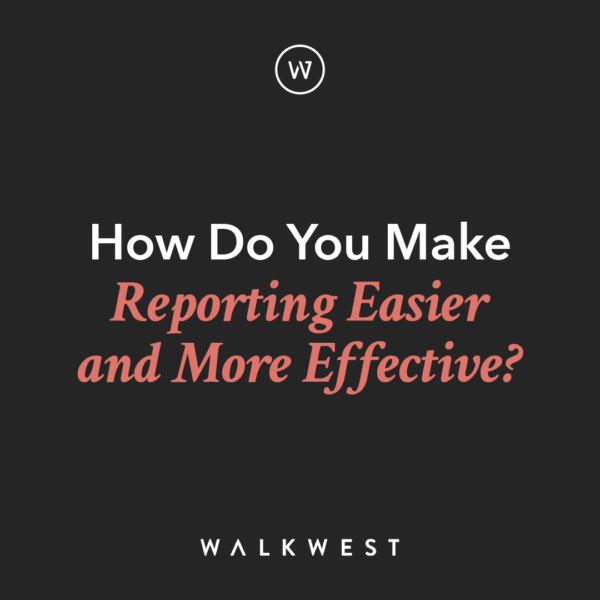Reporting is one of the most important parts of marketing and advertising. How do you know if what you’re doing is working? The right report will tell you. But reporting can also be one of the most challenging parts of marketing. If you’ve read a marketing report, you already know it can be confusing.
The first step is identifying your organization’s goals. Once they align with what you want your marketing to accomplish, you can start setting up your report to determine whether your efforts are effective.
Need help figuring out where to start? Don’t worry — we’ve got exactly what you’re looking for. We asked the experts to create an in-depth guide for creating a marketing report that tells you what you need to know.
Step 1: Identify Important Metrics
A good marketing campaign strategy begins with clarity around what and how you’ll be measuring your results. To properly measure your results, you need to know what metrics are important.
Key performance indicators (KPIs) help you determine your performance. Depending on your online activities, you can track dozens of metrics. Not sure what to focus on? We can help — contact us today.
If you’re tracking your website performance, you should consider total site visits, unique visitors, returning visitors, page views, conversion rates, and session durations.
Launching an email marketing campaign? Then, you’ll need an open rate, clickthrough rate, unsubscribe rate (ouch), and email ROI.
When identifying what metrics are important to your campaign, it’s important to keep in mind different factors that might affect your returns. Depending on what time of year your campaign is launching, its seasonality could alter how it performs. Big events happening at the same time — like the Olympics or the upcoming elections — could also affect your campaign in interesting ways.
Step 2: Set Benchmarks & Track Performance
Before you can assess if you’re doing well, you need a baseline to compare against. You need a benchmark.
A benchmark metric is what you compare all future progress against. To set your benchmarks, you should look at how your marketing campaigns (organic or paid) usually perform. If you’re starting from scratch and don’t have previous metrics to analyze, you can use industry-specific benchmarks or blend the two. Setting specific benchmarks for each platform or tactic you’re using is critical. For example, your search benchmark may differ slightly from your social benchmark. Knowing both is key to a holistic understanding of how all aspects of your marketing are working together.
Once you know your benchmarks, you can set realistic goals for your brand and better understand the performance of your campaigns.
Once your benchmarks and KPIs are set, you can examine your results to see how things performed. You must measure the results you’re currently getting (the KPIs) against your benchmarks to understand whether they work.
Step 3: Interpret Data
If your KPIs are doing better than your benchmarks, congratulations! Your campaign is doing well.
If your campaign is performing below your benchmarks, there are some things you can suggest to the team to turn them around. It largely depends on the channel. The first thing to assess is how the creative is doing on each channel. Most marketing platforms, such as Google Ads and Facebook Ads, provide creative rankings so you can see exactly how each asset is doing.
A/B testing what you have is a great way to see consistent improvements in your results and how your audience reacts to each asset. If that method doesn’t help performance, you might consider shifting the budget to other channels or tactics that might do better overall.
In addition to creative, targeting, bid strategy, and landing page experience are other good areas to explore when optimizing your campaigns.
As you interpret data and develop a plan for what to do next, it’s important to ask questions. For example, if Cost Per Conversion is trending down, do you know why that is? What creative tactics and audience targeting are driving the change? Assessing performance is diving into the data and asking questions to uncover specific insights.
Step 4: Create (and Templatize) Your Report
Setting up your report may vary depending on your campaign’s objective and tools. It’s important to ensure KPIs are easily visible from the beginning and when you present specific metrics. As you go through the report, you’ll want to explore specific channels and tactics in depth to understand the performance fully.
At the end of the report, highlight any other areas that data doesn’t cover, such as next steps or plans for optimization. This is also a good place to reference any benchmarks the campaign aims to meet or exceed.
Are you using GA4 to track your campaign data? This powerful tool helps you dig deeper into your campaign performance, but knowing where to start with it can be challenging. We provide analytics consultation and support for all things GA4, from setting it up to proper account configuration. Let us know if you’d like to learn more!
Step 5: Call In an Expert
Want a better understanding of how every aspect of your campaign is doing? We can help you with that. Data is more critical than ever for ensuring your marketing budget is wisely spent, and we know exactly how to help you track and manage your campaign reports.
We also know how to determine which metrics will have a real-life impact on your business — and your bottom line. Our team of data experts is great at optimizing the metrics that make sense, unlike vanity metrics that look nice but don’t do anything for your business.
Above all else, we can help you make your marketing work smarter to achieve your goals. Contact us today to learn how we can help you achieve more through your marketing.

